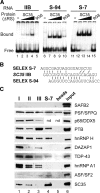Antagonistic factors control the unproductive splicing of SC35 terminal intron
- PMID: 19965769
- PMCID: PMC2831310
- DOI: 10.1093/nar/gkp1086
Antagonistic factors control the unproductive splicing of SC35 terminal intron
Abstract
Alternative splicing is regulated in part by variations in the relative concentrations of a variety of factors, including serine/arginine-rich (SR) proteins. The SR protein SC35 self-regulates its expression by stimulating unproductive splicing events in the 3' untranslated region of its own pre-mRNA. Using various minigene constructs containing the terminal retained intron and flanking exons, we identified in the highly conserved last exon a number of exonic splicing enhancer elements responding specifically to SC35, and showed an inverse correlation between affinity of SC35 and enhancer strength. The enhancer region, which is included in a long stem loop, also contains repressor elements, and is recognized by other RNA-binding proteins, notably hnRNP H protein and TAR DNA binding protein (TDP-43). Finally, in vitro and in cellulo experiments indicated that hnRNP H and TDP-43 antagonize the binding of SC35 to the terminal exon and specifically repress the use of SC35 terminal 3' splice site. Our study provides new information about the molecular mechanisms of SC35-mediated splicing activation. It also highlights the existence of a complex network of self- and cross-regulatory mechanisms between splicing regulators, which controls their homeostasis and offers many ways of modulating their concentration in response to the cellular environment.
Figures







Similar articles
-
hnRNP A1 and the SR proteins ASF/SF2 and SC35 have antagonistic functions in splicing of beta-tropomyosin exon 6B.J Biol Chem. 2004 Sep 10;279(37):38249-59. doi: 10.1074/jbc.M405377200. Epub 2004 Jun 18. J Biol Chem. 2004. PMID: 15208309
-
SC35 and heterogeneous nuclear ribonucleoprotein A/B proteins bind to a juxtaposed exonic splicing enhancer/exonic splicing silencer element to regulate HIV-1 tat exon 2 splicing.J Biol Chem. 2004 Mar 12;279(11):10077-84. doi: 10.1074/jbc.M312743200. Epub 2003 Dec 31. J Biol Chem. 2004. PMID: 14703516
-
Depletion of TDP 43 overrides the need for exonic and intronic splicing enhancers in the human apoA-II gene.Nucleic Acids Res. 2005 Oct 27;33(18):6000-10. doi: 10.1093/nar/gki897. Print 2005. Nucleic Acids Res. 2005. PMID: 16254078 Free PMC article.
-
Evolution of SR protein and hnRNP splicing regulatory factors.Wiley Interdiscip Rev RNA. 2012 Jan-Feb;3(1):1-12. doi: 10.1002/wrna.100. Epub 2011 Sep 2. Wiley Interdiscip Rev RNA. 2012. PMID: 21898828 Free PMC article. Review.
-
Fox-1 family of RNA-binding proteins.Cell Mol Life Sci. 2009 Dec;66(24):3895-907. doi: 10.1007/s00018-009-0120-5. Cell Mol Life Sci. 2009. PMID: 19688295 Free PMC article. Review.
Cited by
-
Integrating 5hmC and gene expression data to infer regulatory mechanisms.Bioinformatics. 2018 May 1;34(9):1441-1447. doi: 10.1093/bioinformatics/btx777. Bioinformatics. 2018. PMID: 29220513 Free PMC article.
-
Disease-associated mutation in SRSF2 misregulates splicing by altering RNA-binding affinities.Proc Natl Acad Sci U S A. 2015 Aug 25;112(34):E4726-34. doi: 10.1073/pnas.1514105112. Epub 2015 Aug 10. Proc Natl Acad Sci U S A. 2015. PMID: 26261309 Free PMC article.
-
An integrated regulatory network reveals pervasive cross-regulation among transcription and splicing factors.PLoS Comput Biol. 2012;8(7):e1002603. doi: 10.1371/journal.pcbi.1002603. Epub 2012 Jul 26. PLoS Comput Biol. 2012. PMID: 22844237 Free PMC article.
-
TDP-43 and FUS/TLS: emerging roles in RNA processing and neurodegeneration.Hum Mol Genet. 2010 Apr 15;19(R1):R46-64. doi: 10.1093/hmg/ddq137. Epub 2010 Apr 15. Hum Mol Genet. 2010. PMID: 20400460 Free PMC article. Review.
-
The centrosomal kinase NEK2 is a novel splicing factor kinase involved in cell survival.Nucleic Acids Res. 2014 Mar;42(5):3218-27. doi: 10.1093/nar/gkt1307. Epub 2013 Dec 24. Nucleic Acids Res. 2014. PMID: 24369428 Free PMC article.
References
-
- Bourgeois CF, Lejeune F, Stevenin J. Broad specificity of SR (serine/arginine) proteins in the regulation of alternative splicing of pre-messenger RNA. Prog. Nucleic Acid Res. Mol. Biol. 2004;78:37–88. - PubMed
-
- Long JC, Caceres JF. The SR protein family of splicing factors: master regulators of gene expression. Biochem. J. 2009;417:15–27. - PubMed
-
- Martinez-Contreras R, Cloutier P, Shkreta L, Fisette JF, Revil T, Chabot B. hnRNP proteins and splicing control. Adv. Exp. Med. Biol. 2007;623:123–147. - PubMed
Publication types
MeSH terms
Substances
LinkOut - more resources
Full Text Sources
Other Literature Sources
Research Materials

